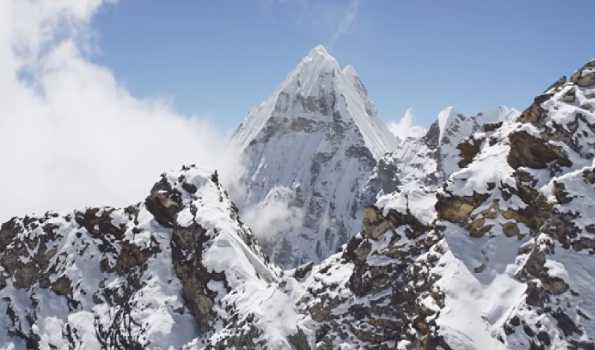Hamirpur : Himalayan glaciers melted due to global warming as a result 155 lakes of 1,000 square meters were formed by 2011. The size is continuously increasing by 2 to 3 times, the crisis of floods hovering over many states, according to Professor Chander Prakash of the NIT, Hamirpur.
Prof. Chandra Prakash of NIT, Hamirpur who has been studying glaciers with his researchers for years has made many startling revelations. The number of lakes formed by melting glaciers in the higher Himalayas and the Pir Panjal range has doubled in the last four decades.
In 1971, the Chandra Bhaga, Beas, and Parvati river basins of the High Himalayas and Pir Panjal range had a total of 77 glacier lakes with an area of 1,000 square meters.
In the year 2011, their number increased to 155.
There has also been an increase of 2 to 3 times in the size of the already existing lakes. The number of these lakes is increasing continuously in the areas of Kashmir, Nepal, Bhutan, Tibet and Sikkim, Uttarakhand, Jammu and Kashmir and Himachal of India.
With the increase in the size and number of lakes, the risk of lakes bursting due to excessive rainfall, glacier breakage and landslides has also increased in these areas, the researcher maintains.
Dr. Chandra Prakash’s research is more focused on the 4 river valleys of the High Himalayas and the Pir Panjal mountain range. This study of glacier lakes has been done with the help of Indian Remote Sensing Satellite data and Corona Aerial Photograph done in 1971 of America.
The Pir Panjal range separating the Chandra and Bhaga basins from the Beas and Parvati basins has also been the focus of this study. However, Glacier Lake has formed more in the last 4 decades in the higher Himalayan range than in the Pir Panjal range.
In the last 4 decades, the Chandra basin has seen a three- fold increase. In the year 1971, a total of 14 lakes were present in this basin, which has now increased to 48. The two largest glacier lakes of the High Himalaya region are present in this basin. The size of the lake formed by Samudra Tapu Glacier is 1.35 square kilometer. Apart from this, the size of Gepang Gath Glacier Lake has also increased manifold in the last 4 decades. Its size was 0.17 square kilometers in the year 1971, which increased to 0.5 square kilometers in the year 2003 and 0.84 square kilometers in the year 2011.
Due to the continuous increase in size, the risk of floods due to bursting of these lakes in the near future has increased. Similarly, due to the natural drainage there, the danger has also been averted to some extent, but the possibility of danger cannot be ruled out.
Glaciers melting due to global warming are a major threat to humanity. Before 2016, 1348 glacier lakes had erupted around the world. 13 thousand people died in these incidents. A total of 45 such incidents happened in the Himalayan region, which caused significant damage in Nepal, Bhutan, Tibet and the Indian region.
At the same time, a major threat from the ever-increasing glacier lakes is being considered for the countries of the Himalayan mountain range.
The study, based on data up to 2011, is shocking, but more shocking revelations could happen in the next 10 years of study. In this study also Prof. Chandra Prakash is busy with his researchers. There is an estimate that these lakes have increased more than expected in the last decade.
It is also believed that if organizations and countries around the world do not take steps on global warming, then many incidents like Chamoli and Kedarnath can be seen in the coming days.
The glaciers are melting continuously and the lakes formed from them can also become a big threat to the countries associated with the Himalayan region in the coming days. Glaciers like Samudratapu and Gepang Gath and the lakes formed from them can prove to be a big challenge in the coming days.
Prof. Chandra Prakash says on this subject that apparently due to global warming, this challenge is being seen. In the coming days, he and his researchers are also working on the study of the next decade.
He has also personally visited and inspected some glaciers of the High Himalayas and Pir Panjal. There is a need to be more vigilant in this direction, he adds.











More Stories
Columbia University aakes back Deadline set for Protesters to Leave Campus
BJD Releases List of 3 Candidates for Odisha Assembly Elections
Low vision clinic inaugurated at AIIMS Bhubaneswar